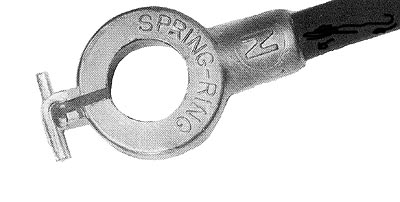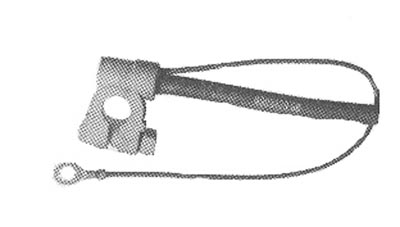
The three biggest fallacies about “New Old Stock” (NOS) parts are the following:
1. That the part numbers listed in the “Parts Catalogues”, and in many other reference books, are the same numbers that are stamped or cast into the parts.
2. That all NOS parts listed in the Parts Catalogues are correct for all the years listed.
3. That all NOS parts are painted, plated, or are identical in shape,
and material to the original parts they were made to replace.
Now, lets attack these items one at a time. We all know the numbers that
are stamped into the housings of 70-72 Stage 1 carburetors, as that is how
they are normally identified, but lets match them up with the numbers from
one of the Buick Parts Catalogues.
Stage1 Carb, Year and Desc Numbers on Body-Stamped Buick Part Numbers from 3/73 Catalog 1970 7040246 7047047 1971 7041242 7047140 1972 49 State 7042242 7046575 1972 Calif. 7042942 7047240
The first thing you notice is that the numbers stamped into the parts do not match the part numbers from the Parts Catalogues. That is because the Parts Catalogues listed the numbers needed to order the replacement parts. These were the numbers assigned to the boxes, and were not necessarily the numbers found on the parts.
One reason GM needed different “ordering" numbers was when they
had to list parts with different finishes. Take the 70-72 455 valve covers,
both the Stage 1 and non-Stage 455 covers used the same stampings, but the
Stage 1’s were chrome plated, while the others were painted. Here is
how the numbers shake out.
You can see that the numbers stamped into the parts are identical regardless of their plating/painting, but GM assigned other numbers for the chrome covers, in order to differentiate the two types they intended to stock.
There are many other examples of this, like the numbers for 72 Skylark/GS plastic grills. The number cast into the part, for both paint schemes, is 1239956. But, the part number for the Skylark/Sport wagon grille is 9608381, while the part number for a GS grill is 9608382.
The problem for us, the restorers, is that it is often difficult, if not impossible, to tell if the numbers listed in many of our reference books are part numbers, or if they are the numbers that are actually stamped into the parts. Information for these books was compiled from many sources, including dealer bulletins and factory assembly information. Many of the service bulletins listed part numbers, so the dealer knew the numbers needed to order the parts, while the factory info often referenced the numbers stamped/cast into the parts.
This confusion over part numbers has led to many horror stories. I often hear of people that sold, or worse, threw out parts they thought were wrong, only to find out later that the parts were indeed correct. A mistake like this can easily cost hundreds of dollars to correct, and possibly add years to your parts searching.
Now lets look at the second item, namely, “That all NOS parts listed in the Parts Catalogues are correct for all the years listed.” Lets use the 70-72 radiator core supports as our example.
If you look at original cars you will notice that the 1970 core supports
had the year 70 stamped into them. This means this part was first used for
the 1970 model year. (Note, GM used this same type of coding in taillight
and other lenses.) Now if you examine original 71-72 cars you will see the
year 71 stamped into all of them. This means that the core supports were
changed slightly for the 71-model year, but the part was left unchanged
throughout the 72-model year. Now lets look at how the assembly manuals
and parts catalogues list them.
The first thing you notice is that originally there were 2 different types of core supports, namely the 70 and 71-72 styles. The second thing is that by March of 1973 GM was only offering the 71-72-type core support as a replacement part for all 3 years. This makes perfect sense, because GM discontinued the 70 style and switched production over to the new 71 style at the beginning of the 71-production year. This also meant that any 1970 car that was wrecked after March of 1973 received a replacement 71-72 style core support if needed.
The key to all this is the word “replacement”. The parts catalogues were designed to supply replacement parts, that could be used to repair the cars listed. GM did this by using parts that were “currently available” in their inventory. This often meant these replacement pieces differed from original components.
Now we turn to the third item, “That all NOS parts are painted, plated, or are identical in shape, and material to the original parts they were made to replace.” This is the one that gives me the most problems. I am often asked the question, “What is the correct part, color, etc, for my car.” Many times, after supplying the answer I hear, “Well that’s not what my NOS piece looks like.” People often take the appearance of an NOS part as Gospel, especially after spending a large chunk of money acquiring it. They figure, how much closer to original, can a brand new genuine GM part be, and sometimes get very angry when told the truth.
Again the key word here is replacement. Many of the NOS pieces for our cars were made years, if not decades, after the actual car production ceased. The idea that a replacement part stayed exactly the same, for this length of time, is not only dumb, but can end up becoming a very costly mistake. There are so many examples of NOS parts being changed, that it would be impossible to list them all.
One example that comes to mind is about battery cables. Years ago I had a guy ask me how long the “pig tail” was on a 70 GS 455 negative battery cable. My response was, “What pig tail, they were spring ring cables and didn’t have any tails.” As the conversation continued, I discovered that he had purchased an NOS cable, like the one pictured on the right. It had the correct part number melted into the casing and was the correct length, but the battery end was completely different then the original style, shown on the left. Obviously GM had changed the design, but retained the same part number. He paid around $60.00 for the cable and was upset that he could not use it for his restoration. He ended up buying a set of reproduction cables that looked just like the originals.


Here are a few other examples of NOS parts that have been changed throughout the years.
70 GS Grills are made from black plastic, instead of gray, and have an extra gusset molded into them at the top of the “V”. The replacements also came with several different and incorrect painting schemes.
Windshield washer pumps, for depressed wipers, have black plastic bodies, instead of the white original types. Some even have a different base plate for later wiring applications.
Delco Remy voltage regulators have the wording embossed in a straight line, while the originals were offset.
70-72 Interior courtesy light lenses are made from clear frosted plastic, instead of white, like the originals.
Ram air cleaner foam seals are made of gray foam, unlike the originals and early replacements that used yellow foam.
The list goes on, and on, and on.
In summary, if you are going to purchase NOS pieces the best thing I can suggest is do your homework. The best sources of information are factory assembly manuals, and the parts on your own cars. If you can verify that the parts on your car are correct, and the NOS parts look different, then assume that the NOS parts are wrong, not vice versa. Also remember that the NOS pieces are often the last version of the part that was produced. So if you are looking for a 1970-driver side front inner fender, you should be prepared to get one for a 72 and not a 70.
The other thing to remember is if you buy an incorrect NOS part,
you still need to find the correct part for your car. Also, unless the part
is correct for another year vehicle, you may end up “eating” the
entire amount you spent. This can sometimes be a hard learned lesson, especially
when the less expensive “reproduction” parts end up being more
correct for your car. Like I said, the agony continues.